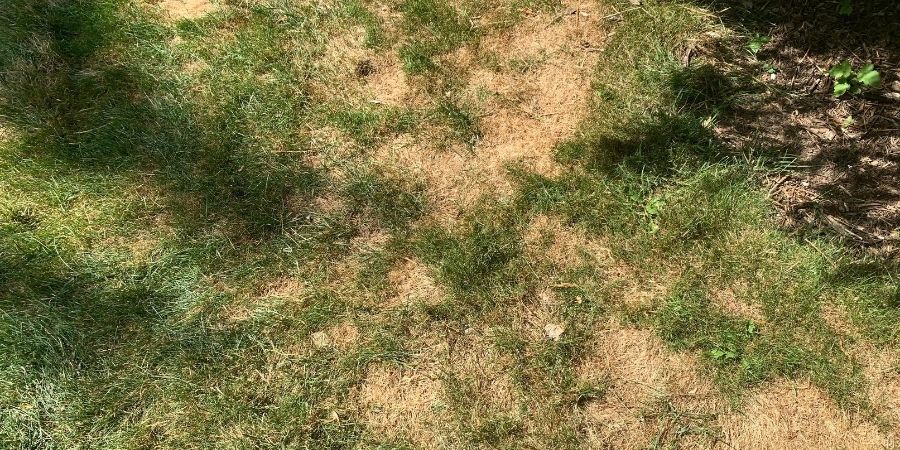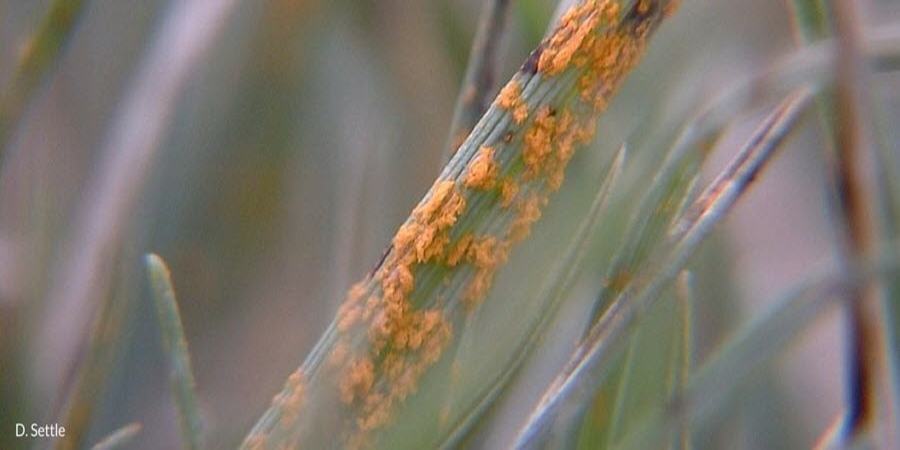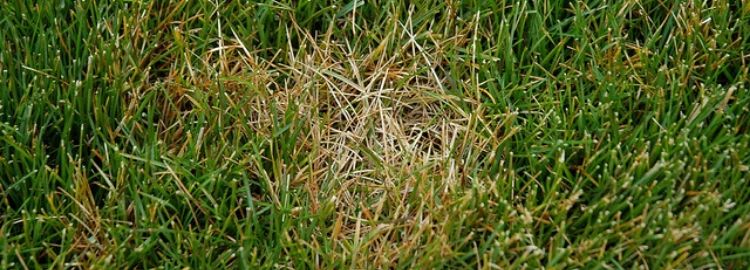Lawn Disease Questions Answered
- Milorganite AgronomistSeptember 12, 2025
Many of us may not have had much time to tend to our lawns over the past few months, and we are starting to notice brown and yellow spots, or a reddish hue, on our shoes, mower, or pets.
A few common lawn diseases that I've been receiving a lot of customer questions about are brown patch, rust, and dollar spot.
Are You Seeing dead, brown, or struggling grass? Let’s see if it’s a lawn disease.
There are three factors that cause lawns to become diseased:
- A disease-causing pathogen
- Susceptible grass species
- A favorable environment for the pathogen
A lawn disease will blossom if all three criteria take place simultaneously for a time period that the pathogen needs to settle in. If any of these three criteria aren’t present, your lawn should be free of diseases.
The first step in addressing a problem area on your lawn is to identify the species of grass you have: a northern, cool-season grass or a southern, warm-season grass, because different species are susceptible to different diseases.
Brown Patch Lawn Disease: A Fungus That Survives in Thatch
Many of our customers’ lawns have been affected by a fungus this summer: brown patch, which survives in thatch and other debris, awaiting the next period of hot, humid weather.
Brown patch thrives in hot, humid weather, generally when evening temperatures are above 65°F, and where there’s an excess of nitrogen in the soil. It results in poor-quality turf, causing grass blades to turn dark and wilt, and die quickly.
All warm-season grass varieties are susceptible to brown patch, particularly St. Augustinegrass and Zoysiagrass, from November through May. Cool-season grass varieties, especially Bluegrass, Fescue, and Ryegrass, are susceptible from mid-June through early-September.

Brown patch, not surprisingly, causes large patches of lawn to turn brownish-tan of up to 3 feet in diameter on cool-season grasses during hot, humid weather. Often, you can see a dark purple or greyish “smoke ring” around the border of the diseased area. On warm-season grasses, patches can reach up to 20 feet in diameter during cool, wet weather, generally in spring or fall.
To manage brown patch, avoid applying excess nitrogen to your lawn, especially from quick-release or soluble liquid fertilizers. Be sure to aerate your lawn to avoid soil compaction. If a certain area of the lawn consistently develops the disease, ensure there is good air circulation in the area and adequate sunlight. To help prevent over-fertilization, have your soil tested to identify what nutrients that are lacking. In the case of these two diseases, one low N can contribute to the disease, while the other can be caused by high N. It’s not a bad idea to have the soil tested by a university every 3-5 years just to better understand where your nutrient levels are at, especially if you have recurring disease issues. Stick to an annual fertilization schedule using a low-nitrogen, slow-release fertilizer such as Milorganite, which provides nutrients at a rate plants need.
Water deeply and infrequently early in the day to allow grass blades to dry out.
Mow affected areas last, and gather and dispose of the clippings in the trash to help prevent the disease from spreading. When finished, rinse and dry the mower blades. Reducing thatch to increase air circulation will also help.
Lawns damaged by brown patch usually recover when more favorable growing conditions return.
Fungicides are rarely needed to treat brown patch.
Lawn Rust Disease: What You Need to Know
Rust is a fungal disease that affects grass, causing small yellow specks on leaf blades/stems that eventually develop orange or red “pustules.” If the infection becomes severe, the lawn may visibly thin or develop an orange/reddish cast. Rust can also show up on your shoes or lawnmower after mowing.

How to Manage and Prevent Rust
-
Fertilize regularly — Rust often arises when grass is lacking nitrogen. Keeping up a good fertilization schedule helps. Milorganite
-
Mow smart — Cut healthy areas first; leave diseased areas last. This helps reduce spread. Clean mower blades after mowing rust-infected grass. Milorganite
-
Water deeply & infrequently — Do this early in the day so the grass has time to dry. Moist, prolonged wetness tends to favor fungal growth. Milorganite
-
Dispose of clippings when rust is present, rather than letting the clippings fall back on the lawn. This helps reduce spores and disease buildup. Milorganite
Grass Types & When It Happens
-
Cool-season grasses (North):
-
Bluegrass, Ryegrass, Tall Fescue
-
Typically shows up during summer into early fall, especially under drought stress or low fertility.
-
-
Warm-season grasses (South):
-
Includes St. Augustinegrass, Zoysiagrass, and perennial ryegrass, especially when used for winter overseeding
-
Rust occurs primarily from May through October, often due to nitrogen deficiency and/or drought.
-
Symptoms to Watch For
-
Tiny yellow spots on grass blades & stems
-
Progression into orange or red pustules
-
Reddish/orange hue across parts of the lawn (especially if widespread)
-
Thinning of grass in infected areas
-
Rust particles left on shoes or mowing equipment after use
Dollar Spot - Spreads Through Infested Leaf Blades
Dollar spot causes straw-colored patches in the lawn that are 2 to 6 inches in diameter. The grass blades will have hourglass-shaped lesions with reddish-brown margins. In the morning dew, the patch may look as though it’s covered in spider webs. This is the branching mycelium of the dollar spot fungus. The mycelium “disappears” when the dew dries.
Proper fertilization and watering can help manage dollar spot.

Nitrogen-poor soils contribute to the spread of dollar spot. Maintaining an annual fertilization schedule using a slow-release fertilizer, such as Milorganite, will help restore depleted nitrogen.
Lawns generally need 1” of rain or irrigation every week. Watering deeply and infrequently is the most effective method. Short sprinkles from a hose promote shallow root growth and weaken grass. Watering early in the day, from 4 a.m. to 10 a.m., allows the grass to dry more quickly than watering in the evening.
Dollar spot is spread through infested leaf blades. Mow unaffected areas before moving on to areas with dollar spot. Rake up grass clippings and dispose of them in the trash. Rinse and dry mower blades afterward mowing. These steps can help prevent unintentionally spreading the disease.
Fungicide is rarely necessary to control dollar spot.
Dollar spot is a fungus that affects both cool-season (Bluegrass and Ryegrass) and warm-season (bermudagrass, Centipedegrass, and Zoysiagrass) grass varieties. It flourishes in both drought conditions and when grass blades are wet for a prolonged period of time.
Cool-season grass varieties are susceptible to dollar spot between late-March and early-November—essentially the entire growing season. Look for dollar spot on warm-season grass varieties from May through September.
Not Seeing the Lawn Issue in Your Yard?
Visit our lawn diseases page for pictures and descriptions of several common turf diseases. See if one of these looks like the problem your lawn is having, and if the description fits. If it does, you may have found your culprit. We’ve included tips on how to manage the problem and nurture your lawn back to good health.
The turf diseases listed are rarely detrimental to your lawn, and fungicides generally aren’t needed for treatment, which could harm the environment and simply be a waste of money. Proper lawn care is the best option for preventing and treating these common turf diseases.
Continue to monitor for lawn diseases throughout the seasons. If patches of your lawn are damaged by a disease, don’t forget to add “repairing damaged patches of lawn” to your list of fall yard and garden activities.

